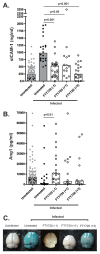S1P is associated with protection in human and experimental cerebral malaria
- PMID: 21556483
- PMCID: PMC3146616
- DOI: 10.2119/molmed.2010.00214
S1P is associated with protection in human and experimental cerebral malaria
Abstract
Cerebral malaria (CM) is associated with excessive inflammatory responses and endothelial activation. Sphingosine 1-phosphate (S1P) is a signaling sphingolipid implicated in regulating vascular integrity, inflammation and T-cell migration. We hypothesized that altered S1P signaling during malaria contributes to endothelial activation and inflammation, and show that plasma S1P levels were decreased in Ugandan children with CM compared with children with uncomplicated malaria. Using the Plasmodium berghei ANKA (PbA) model of experimental CM (ECM), we demonstrate that humanized S1P lyase (hS1PL)(-/-) mice with reduced S1P lyase activity (resulting in increased bio-available S1P) had improved survival compared with wild-type littermates. Prophylactic and therapeutic treatment of infected mice with compounds that modulate the S1P pathway and are in human trials for other conditions (FTY720 or LX2931) significantly improved survival in ECM. FTY720 treatment improved vascular integrity as indicated by reduced levels of soluble intercellular adhesion molecule (sICAM), increased angiopoietin 1 (Ang1) (regulator of endothelial quiescence) levels, and decreased Evans blue dye leakage into brain parenchyma. Furthermore, treatment with FTY720 decreased IFNγ levels in plasma as well as CD4(+) and CD8(+) T-cell infiltration into the brain. Finally, when administered during infection in combination with artesunate, FTY720 treatment resulted in increased survival to ECM. These findings implicate dysregulation of the S1P pathway in the pathogenesis of human and murine CM and suggest a novel therapeutic strategy to improve clinical outcome in severe malaria.
Figures





References
-
- Severe falciparum malaria. World Health Organization, Communicable Diseases Cluster. Trans. R. Soc. Trop. Med. Hyg. 2000;94(Suppl 1):S1–90. - PubMed
-
- van der Heyde HC, Nolan J, Combes V, Gramaglia I, Grau GE. A unified hypothesis for the genesis of cerebral malaria: sequestration, inflammation and hemostasis leading to micro-circulatory dysfunction. Trends Parasitol. 2006;22:503–8. - PubMed
-
- Hait NC, Oskeritzian CA, Paugh SW, Milstien S, Spiegel S. Sphingosine kinases, sphingosine 1-phosphate, apoptosis and diseases. Biochim Biophys Acta. 2006;1758:2016–26. - PubMed
-
- Spiegel S, Milstien S. Sphingosine-1-phosphate: an enigmatic signalling lipid. Nat Rev Mol Cell Biol. 2003;4:397–407. - PubMed
Publication types
MeSH terms
Substances
Grants and funding
LinkOut - more resources
Full Text Sources
Other Literature Sources
Research Materials
Miscellaneous

